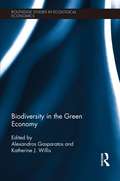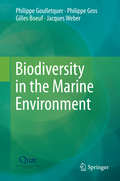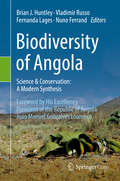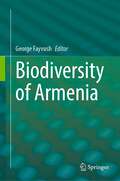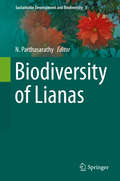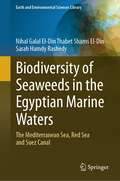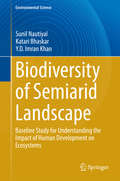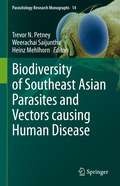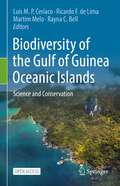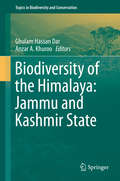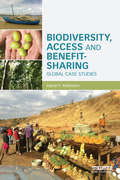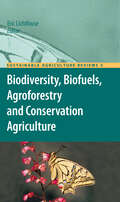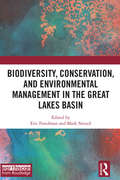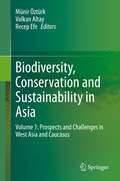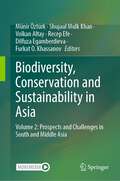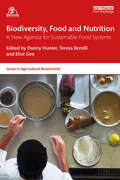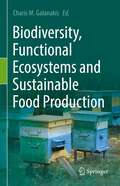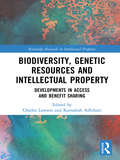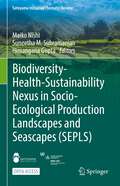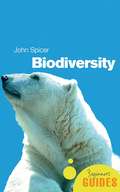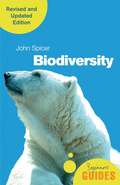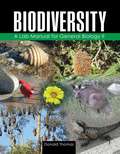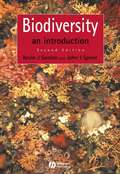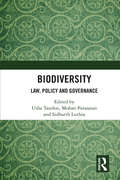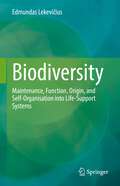- Table View
- List View
Biodiversity in the Green Economy (Routledge Studies in Ecological Economics)
by Alexandros Gasparatos Katherine J. WillisIn the past decade, the growing realization that biodiversity and human wellbeing are inextricably linked has led to the adoption of numerous environmental policies. The concept of the Green Economy has gained particular attention as an economic system where growth is possible within environmental limits. The preservation of ecosystem services and the halt of biodiversity loss are identified as key pillars of the Green Economy. Despite the concept’s momentum there is still no clear understanding of how biodiversity fits within a Green Economy. In the current debate, biodiversity is rarely acknowledged in economic sectors other than agriculture, forestry, fisheries and tourism, and when it is acknowledged biodiversity and its conservation feature more as buzzwords than as concrete and tangible components of the Green Economy. This book aims to identify, understand and offer pragmatic recommendations of how biodiversity conservation can become an agent of green economic development. This book establishes ways to assess biodiversity’s contributions to the economy and to meaningfully integrate biodiversity concerns in green-economy policies.
Biodiversity in the Marine Environment
by Philippe Goulletquer Philippe Gros Gilles Boeuf Jacques WeberThe oceans cover over 70% of our planet. They are host to a biodiversity of tremendous wealth. Its preservation is now a global priority featuring in several international conventions and a confirmed objective of European policies and national strategies. Understanding the dynamics and the uses of the marine biodiversity is a genuine scientific challenge. Fourteen international experts have got together and identified five priority research themes to address the problem, based on analysing the state of knowledge.
Biodiversity of Angola: Science And Conservation: A Modern Synthesis
by Brian J. Huntley Vladimir Russo Fernanda Lages Nuno FerrandThis open access multi-authored book presents a 'state of the science' synthesis of knowledge on the biodiversity of Angola, based on sources in peer-reviewed journals, in books and where appropriate, unpublished official reports. The book identifies Angola as one of the most biologically diverse countries in Africa, but notes that its fauna, flora, habitats and the processes that drive the dynamics of its ecosystems are still very poorly researched and documented. <P><P> This 'state of the science' synthesis is for the use of all students of Angola's biodiversity, and for those responsible for the planning, development and sustainable management of the country's living resources. The volume brings together the results of expeditions and research undertaken in Angola since the late eighteenth century, with emphasis on work conducted in the four decades since Angola's independence in 1975. The individual chapters have been written by leaders in their fields, and reviewed by peers familiar with the region.
Biodiversity of Armenia
by George FayvushArmenia is a small landlocked mountainous country located in the Southern Caucasus. It is a typical mountainous country, having its lowest point of 375m above sea level and culminating at 4095m with an average altitude of 1850m, where the landscapes and ecosystems form a complex multi-functional system. In general, the ecosystems of Armenia are characterized by a number of peculiarities, which all together contribute to formation of rich and unique biodiversity. On the small territory of Armenia (less than 30 thousand km2) there are about 3800 species of vascular plants (about a half of the whole Caucasian flora), 428 species of soil and water algae, 399 species of mosses, 4207 species of fungi, 464 species of lichens, 549 species of vertebrates and about 17200 species of invertebrates. The biodiversity of Armenia is notable for high endemism: about 500 species of fauna (about 3% of the fauna) and 147 species of flora (3.8% of total flora) are considered endemics. Such a high level of endemism is typical only for some of the large islands. Due to the huge variety of climates (from dry subtropics to cold alpine) and soil conditions all the main Caucasian ecosystems (besides humid subtropics) are represented in Armenia – deserts and semi-deserts, steppes, meadow-steppes, forests and open woodlands, sub-alpine and alpine vegetation as well as intrazonal ecosystems. Therefore Armenia is a biodiversity hotspot both within the Caucasian ecoregion and around the globe. This book compiles, summarizes and analyzes data on flora, fauna and mycobiota of Armenia, with a special focus on the impact of forecasted climate change on biodiversity and ecosystems of the region.
Biodiversity of Lianas (Sustainable Development and Biodiversity #5)
by N. ParthasarathyThis book "Biodiversity of lianas" under the series "Sustainable development and Biodiversity" is unique as it covers a wide array of topics in this subject covering all continents and will constitute a valuable reference material for students, researchers and forest managers who are concerned with biodiversity, forest ecology and sustainable development of forest resources. It contains peer-reviewed chapters from leading academicians and researchers around the world in the field of Plant Ecology, Taxonomy and related areas of Biodiversity Science but, centered on Lianology and includes original research articles, case studies and reviews (regional and global) in biodiversity, ecology and phytogeography and conservation of lianas from temperate, sub-tropical and tropical forests. The interest in lianas has increased over the last two decades. The ultimate goal of this book is to provide an insight into the patterns of liana diversity, distribution, the role of lianas in structuring forest community, and functional ecology (carbon uptake, ecosystem services, dynamics and invasion), biotechnological tool for conservation of lianas and finally summarizes the significance and the need for conservation of lianas in the changing global environmental scenario.
Biodiversity of Seaweeds in the Egyptian Marine Waters: The Mediterranean Sea, Red Sea and Suez Canal (Earth and Environmental Sciences Library)
by Nihal Galal El-Din Thabet Shams El-Din Sarah Hamdy RashedyThe Arab Republic of Egypt enjoys a vital strategic location. Its northern border is the Mediterranean Sea, and its eastern border is the Red Sea, which give it a special significance from the bio-diversity point of view as a coastal zone, and as a sensitively diversified ecosystem. The shoreline of the Arab Republic of Egypt is about 3,000 km long. It is about 1,150 km long on the Mediterranean and about 1,850 km long on the Red Sea, which are connected by the Suez Canal, which is about 193.30 km in length. The three water masses are different ecologically and are experiencing wide range of pressures due to, eutrophication, coastal development, aquaculture and climate change. These conditions resulted in several species of seaweeds that adapt to these pressures and expand their living boundaries while others may fade away. Accordingly, the study of seaweeds biodiversity in the Egyptian marine waters is of great concern globally and constitutes an important element of global change research. The present book entitled Biodiversity of Seaweeds in the Egyptian Marine Waters summarizes our current understanding of the biodiversity of seaweeds in the Egyptian marine waters. It is a timely publication based wholly on primary data which were collected through extensive field studies conducted over the years covering the marine Egyptian waters and culminate the efforts of the Egyptian phycologists. The book contains high-quality images of some species in their existing habitats. This book gains critical importance from the fact that the Egyptian marine environment is witnessing rapid development, which will no doubt have a bearing on the coastal environment – and the baseline data on seaweed biodiversity would be useful to understand changes that may arise from physical changes in the environment as also pollution load and climate change.
Biodiversity of Semiarid Landscape: Baseline Study for Understanding the Impact of Human Development on Ecosystems (Environmental Science and Engineering)
by Sunil Nautiyal Katari Bhaskar Y.D. Imran KhanThis study presents authentic data compiled from field experiments and investigations, and provides a point of reference for any future changes associated with anthropogenic activity in semiarid ecosystems. Three years of continuous and rigorous empirical research on biodiversity (from phytoplankton to higher plants and from zooplankton to higher animals - all flora and fauna) in India's semiarid region have culminated in this work. Though there are many studies available on issues related to biodiversity, the majority cover either specific groups of plants or groups of animals; with the exception of this book, studies that include all flora and fauna including the phyto- and zooplanktons in a given ecosystem are not readily available. Further, the book focuses on an extremely important topic, firstly because semiarid landscapes are highly vulnerable to climate change, and secondly because other developmental activities will be undertaken in the region in an effort to meet its energy requirements. As such, the results of the current study will provide a standard protocol for subsequent monitoring and mapping of biodiversity for conservation and management. The book explores, quantifies and surveys plant and animal species from aquatic and terrestrial ecosystems, assessing and quantitatively analyzing the diversity indices of different vegetation strata. Further, it investigates the conservation status of each species (flora and fauna) in keeping with IUCN categories. The study also examines landscape dynamics using RS and GIS for vegetation analysis, and discusses traditional ecological knowledge related to the use, conservation and management of biodiversity. As such, it offers a unique and valuable resource not only for researchers from the environmental/ecological sciences but also for conservationists and policymakers.
Biodiversity of Southeast Asian Parasites and Vectors causing Human Disease (Parasitology Research Monographs #14)
by Trevor N. Petney Heinz Mehlhorn Weerachai SaijunthaThis thematic collection focuses on key parasites and their vectors in Southeast Asia. Up-to-date essays invite readers to discover parasite and vector morphology, genetic diversity as well as dynamic parasite communities linked to human land-use and climate change. The authors shed light on transmission pathways and explore tick-borne diseases, intestinal protozoa, cestodes, nematodes and the multiplicity of cryptic trematode species. Particular attention is given to mosquito vectors in changing environments and the dynamic biodiversity of vertebrate hosts, including mammals, birds and fish.The richly illustrated chapters are completed by new approaches in diagnostic methods, treatment and prevention to protect humans and animals from tropical parasite infections. Not only parasitologists and experts in tropical medicine but also public health officials and travelers will find this volume highly informative.
Biodiversity of the Gulf of Guinea Oceanic Islands: Science and Conservation
by Luis M. P. Ceríaco Ricardo F. de Lima Martim Melo Rayna C. BellThis open access book presents a comprehensive synthesis of the biodiversity of the oceanic islands of the Gulf of Guinea, a biodiversity hotspot off the west coast of Central Africa. Written by experts, the book compiles data from a plethora of sources – archives, museums, bibliography, official reports and previously unpublished data – to provide readers with the most updated information about the biological richness of these islands and the conservation issues they face. The Gulf of Guinea Oceanic Islands (Príncipe, São Tomé and Annobón and surrounding islets) present extraordinary levels of endemism across different animal, fungi and plant groups. This very high endemism likely results from the long geological history of the islands and their proximity to the diversity-rich continent. Many researchers, students and conservationists from across the globe are interested in documenting biodiversity on the islands, understanding the evolutionary origins of this diversity, and mitigating the impacts of global change on this unique archipelago. This book aims to be a primer for a broad audience seeking baseline biodiversity information and to serve as a roadmap for future research efforts aiming to fill knowledge gaps in understanding and conserving the unparalleled biodiversity of the Gulf of Guinea islands.
Biodiversity of the Himalaya: Jammu and Kashmir State (Topics in Biodiversity and Conservation #18)
by Ghulam Hassan Dar Anzar A. KhurooThe Himalaya, a global biodiversity hotspot, sustains about one-fifth of the humankind. Nestled within the north-western mountain ranges of the Himalaya, the Jammu and Kashmir (J&K) State harbours more than half of the biodiversity found in the Indian Himalaya. The wide expanse of State, spread across the subtropical Jammu, through the temperate Kashmir valley, to the cold arid Ladakh, is typical representative of the extensive elevational and topographical diversity encountered in the entire Himalaya.This book, the most comprehensive and updated synthesis ever made available on biodiversity of the J&K State, is a valuable addition to the biodiversity literature with global and regional relevance. The book, arranged into 7 parts, comprises of 42 chapters contributed by 87 researchers, each of whom is an expert in his/her own field of research. The precious baseline data contained in the book would form the foundation for assessing current status of knowledge about the bioresources, identify the knowledge gaps, and help prioritization of conservation strategies to steer the sustainable use of biodiversity in this Himalayan region. Given the breadth of topics covered under the banner of biodiversity in this book, it can surely serve as a model for documentation of biodiversity in other regions of the world. The book will be of immense value to all those who, directly or indirectly, have to deal with biodiversity, including students, teachers, researchers, naturalists, environmentalists, resource managers, planners, government agencies, NGOs and the general public at large.
Biodiversity, Access and Benefit-Sharing: Global Case Studies
by Daniel F. RobinsonThe Nagoya Protocol to the Convention on Biological Diversity (CBD) is rapidly receiving signatures and ratifications. Many countries are preparing to implement the protocol through national research permit systems and/or biodiversity laws. Yet there is still considerable confusion about how to implement the Protocol, regarding access and benefit-sharing (ABS) procedures, and minimal experience in many countries. This book seeks to remedy this gap in understanding by analysing a number of ABS case studies in light of the Nagoya Protocol. The case studies are wide-ranging, with examples of plants for medicinal, cosmetic, biotech and food products from or for development in Australia, North Africa, Madagascar, Switzerland, Thailand, USA and Oceania. These will encourage countries to develop national systems which maximise their benefits (both monetary and non-monetary) towards conservation and support for local communities that hold traditional knowledge. In addition, the author analyses new expectations raised by the Nagoya Protocol, such as the encouragement of the development of community protocols by indigenous and local communities. As a result, stakeholders and policy-makers will be able to learn the steps involved in establishing ABS agreements, issues that arise between stakeholders, and the types of benefits that might be realistic.
Biodiversity, Biofuels, Agroforestry and Conservation Agriculture (Sustainable Agriculture Reviews #5)
by Eric LichtfouseSustainable agriculture is a rapidly growing field aiming at producing food and energy in a sustainable way for our children. This discipline addresses current issues such as climate change, increasing food and fuel prices, starvation, obesity, water pollution, soil erosion, fertility loss, pest control and biodiversity depletion. Novel solutions are proposed based on integrated knowledge from agronomy, soil science, molecular biology, chemistry, toxicology, ecology, economy, philosophy and social sciences. As actual society issues are now intertwined, sustainable agriculture will bring solutions to build a safer world. This book series analyzes current agricultural issues, and proposes alternative solutions, consequently helping all scientists, decision-makers, professors, farmers and politicians wishing to build safe agriculture, energy and food systems for future generations.
Biodiversity, Conservation and Environmental Management in the Great Lakes Basin
by Eric Freedman Mark NeuzilThe Great Lakes Basin in North America holds more than 20 percent of the world's fresh water. Threats to habitats and biodiversity have economic, political, national security, and cultural implications and ramifications that cross the US-Canadian border. This multidisciplinary book presents the latest research to demonstrate the interconnected nature of the challenges facing the Basin. Chapters by U.S. and Canadian scholars and practitioners represent a wide range of natural science and social science fields, including environmental sciences, geography, political science, natural resources, mass communications, environmental history and communication, public health, and economics. The book covers threats from invasive species, industrial development, climate change, agricultural and chemical runoff, species extinction, habitat restoration, environmental disease, indigenous conservation efforts, citizen engagement, environmental regulation, and pollution.Overall the book provides political, cultural, economic, scientific, and social contexts for recognizing and addressing the environmental challenges faced by the Great Lakes Basin.
Biodiversity, Conservation and Sustainability in Asia: Volume 1: Prospects and Challenges in West Asia and Caucasus
by Münir Öztürk Recep Efe Volkan AltayOf the world’s seven continents, Asia is the largest. Its physical landscapes, political units, and ethnic groups are both wide-ranging and many. Southwest, South and Middle Asia are highly populated regions which, as a whole, cover an extremely large area of varied geography. In total, this domain is unique in its plant diversity and large vegetation zones with different communities and biomes. It is rich in endemics, with specific and intraspecific diversity of fruit trees and medicinal plants, including a number of rare, high value, species. At the same time, much of the land in the region is too dry or too rugged, with many geographical extremes. Overgrazing, oil and mineral extraction, and poaching are the major threats in the area.This two-volume project focuses on the dynamic biodiversity of the region with in-depth analysis on phytosociology, plants, animals and agroecology. There are also chapters that explore new applications as well as approaches to overcome problems associated with climate change. Much of the research and analysis are presented here for the first time. We believe this work is a valuable resource for professionals and researchers working in the fields of plant diversity and vegetation, animal diversity and animal populations, and geo-diversity and sustainable land use, among others.The first volume guides our readers to West Asia and the Caucasus region, while volume two focuses on issues unique to South and Middle Asia.
Biodiversity, Conservation and Sustainability in Asia: Volume 2: Prospects and Challenges in South and Middle Asia
by Dilfuza Egamberdieva Münir Öztürk Recep Efe Volkan Altay Shujaul Mulk Khan Furkat O. KhassanovOf the world’s seven continents, Asia is the largest. Its physical landscapes, political units, and ethnic groups are both wide-ranging and many. Southwest, South and Middle Asia are highly populated regions which, as a whole, cover an extremely large area of varied geography. In total, this domain is unique in its plant diversity and large vegetation zones with different communities and biomes. It is rich in endemics, with specific and intraspecific diversity of fruit trees and medicinal plants, including a number of rare, high value, species. At the same time, much of the land in the region is too dry or too rugged, with many geographical extremes. Overgrazing, oil and mineral extraction, and poaching are the major threats in the area. This two-volume project focuses on the dynamic biodiversity of the region with in-depth analysis on phytosociology, plants, animals and agroecology. There are also chapters that explore new applications as well as approaches to overcome problems associated with climate change. Much of the research and analysis are presented here for the first time. We believe this work is a valuable resource for professionals and researchers working in the fields of plant diversity and vegetation, animal diversity and animal populations, and geo-diversity and sustainable land use, among others.The first volume guides our readers to West Asia and the Caucasus region, while volume two focuses on issues unique to South and Middle Asia.
Biodiversity, Food and Nutrition: A New Agenda for Sustainable Food Systems (Issues in Agricultural Biodiversity)
by Danny HunterThis book examines the challenges and impacts of poor diets and nutrition from current food systems and the potential contribution of biodiversity and ecosystem services in addressing these problems. There is a strong need for a multi-level, cross-sectoral approach that connects food biodiversity conservation and sustainable use to address critical problems in our current food systems, including malnutrition. Building on research from the Biodiversity for Food and Nutrition Project (BFN), which aims to better link biodiversity, diets and nutrition, the book presents a multi-country, cross-sectoral analysis of initiatives that have promoted local food biodiversity in four countries: Brazil, Kenya, Turkey and Sri Lanka. This book offers a comprehensive summary of the BFN Project results in each of the four countries along with lessons learned and how this work could be upscaled or applied in other regions. It argues that the strategic promotion and use of food biodiversity is critical in uniting attempts to address conservation, nutrition and livelihood concerns. The book is structured around chapters and case studies encompassing the BFN Project with specific experiences related by partners who played key roles in the work being done in each country. By offering a comparative view capable of furthering dialogue between the respective countries, it is also meant to connect the individual cases for a “greater than the sum of its parts” effect. This means consideration of how localized activities can be adapted to more countries and regions. Therefore, the book addresses global issues with a foot planted firmly in the grounded case study locations. This book will be of great interest to policymakers, practitioners and NGOs working on food and nutrition, as well as students and scholars of agriculture, food systems and sustainable development.
Biodiversity, Functional Ecosystems and Sustainable Food Production
by Charis M. GalanakisIn recent decades, practices like the cultivation of a few high-yielding crop varieties on a large scale, the application of heavy machinery and continued mechanization of agriculture, the removal of natural habitats, and the application of pesticides and synthetics have resulted in the simplification of agro-ecosystems. This has enabled a substantial increase in food production but has at the same time transformed landscapes. Indeed, there is a concern that a decline in biodiversity has affected microbiome activities that support processes across soils, plants, animals, the marine environment, and humans. Although they have increased food production, the above practices cannot be considered sustainable in long-term applications. Biodiversity, Functional Ecosystems, and Sustainable Food Production explore ecosystems in terms of crop and animal production, pest and disease control, nutrient cycling, and soil fertility. Chapters range from agro-biodiversity to antimicrobial use in animal food production to microbiome applications for sustainable food systems and the impacts of environment-friendly unit operations on the functional properties of bee pollen. By examining such topics about each other, the text emphasizes how food production, ecosystem function, food quality, and consumer health are all interconnected.
Biodiversity, Genetic Resources and Intellectual Property: Developments in Access and Benefit Sharing (Routledge Research in Intellectual Property)
by Charles Lawson Kamalesh AdhikariDebates about Access and Benefit Sharing (ABS) have moved on in recent years. An initial focus on the legal obligations established by international agreements like the United Nations Convention on Biological Diversity and the form of obligations for collecting physical biological materials have now moved to a far more complex series of disputes and challenges about the ways ABS should be implemented and enforced: repatriation of resources, technology transfer, traditional knowledge and cultural expressions; open access to information and knowledge, naming conventions, farmers’ rights, new schemes for accessing pandemic viruses and sharing DNA sequences, and so on. Unfortunately, most of this debate is now crystallised into apparently intractable discussions such as implementing the certificates of origin, recognising traditional knowledge and traditional cultural expression as a form of intellectual property, and sovereignty for Indigenous peoples. Not everything in this new marketplace of ABS has been created de novo. Like most new entrants, ABS has disrupted existing legal and governance arrangements. This collection of chapters examines what is new, what has been changed, and what might be changed in response to the growing acceptance and prevalence of ABS of genetic resources. Biodiversity, Genetic Resources and Intellectual Property: Developments in Access and Benefit Sharing of Genetic Resources addresses current issues arising from recent developments in the enduring and topical debates about managing genetic resources through the ABS regime. The book explores key historical, doctrinal, and theoretical issues in the field, at the same time developing new ideas and perspectives around ABS. It shows the latest state of knowledge and will be of interest to researchers, academics, policymakers, and students in the fields of intellectual property, governance, biodiversity and conservation, sustainable development, and agriculture.
Biodiversity-Health-Sustainability Nexus in Socio-Ecological Production Landscapes and Seascapes (Satoyama Initiative Thematic Review)
by Himangana Gupta Maiko Nishi Suneetha M. SubramanianThis is an open access book. It is a compilation of case studies that provide useful knowledge and lessons that derive from on-the-ground activities and contribute to policy recommendations, focusing on the interlinkages between biodiversity and multiple dimensions of health (e.g., physical, mental, and spiritual) in managing socio-ecological production landscapes and seascapes (SEPLS). This book provides insights on how SEPLS approaches can contribute to more sustainable management of natural resources, achieving global biodiversity and sustainable development goals, and good health for all. It is also expected to offer useful knowledge and information for an upcoming three-year thematic assessment of “the interlinkages among biodiversity, water, food, and health” (the so-called “nexus assessment”) by the Intergovernmental Science-Policy Platform on Biodiversity and Ecosystem Services (IPBES). The book begins with an introductory chapter followed by eleven case study chapters demonstrating the nexus between biodiversity, health, and sustainable development, and then a synthesis chapter clarifying the relevance of the case study findings to policy and academic discussions. It will be of interest to scholars, policymakers, and professionals in the field related to sustainable development.
Biodiversity: A Beginner's Guide (Beginner's Guides)
by John SpicerIn this steadfast and yet witty guide, biologist John Spicer examines biodiversity, giving the reader an insight into the myriad of organisms that surround us.
Biodiversity: A Beginner's Guide (revised and updated edition) (Beginner's Guides)
by John SpicerOur future is closely tied to that of the variety of life on Earth, and yet there is no greater threat to it than us. From population explosions and habitat destruction to climate change and mass extinctions, John Spicer explores the causes and consequences of our biodiversity crisis. In this revised and updated edition, he examines how grave the situation has become over the past decade and outlines what we must do now to protect and preserve not just nature&’s wonders but the essential services that biodiversity provides for us, seemingly for nothing.
Biodiversity: A Lab Manual For General Biology II
by Donald R. ThomasThis lab manual is intended to accompany the General Biology II course at Southwest Tennessee Community College. This course focuses on the evolution and diversity of living organisms with attention to comparative anatomy within the vertebrate animals. The manual contains instructions for hands-on examination of specimens with minimal repetition of content found in the recommended textbook (Biology. Solomon and Berg, current edition). This format is used with the motive of saving costs for the student and encouraging the use of the text and the instructor s assistance for explaining unfamiliar vocabulary. In addition to the illustrations in this manual, students may also find photographs and anatomical diagrams of the subjects on the internet as well as in the textbook"
Biodiversity: An Introduction
by Kevin J. Gaston John I. SpicerCLICK HERE TO DOWNLOAD ARTWORK This concise introductory text provides a complete overview of biodiversity - what it is, how it arose, its distribution, why it is important, human impact upon it, and what should be done to maintain it. Timely overview of the serious attempts made to quantify and describe biodiversity in a scientific way Acts as an easy entry point into the primary literature Provides real-world examples of key issues, including illustrations of major temporal and spatial patterns in biodiversity Designed primarily with undergraduate students and course lecturers in mind, it will also be of interest to anyone who requires an overview of, and entry to, the vast literature on these topics. All the figures included in the book are downloadable from the Blackwell Publishing website
Biodiversity: Law, Policy and Governance
by Usha Tandon Mohan Parasaran Sidharth LuthraConservation of biodiversity is a fundamental concern towards securing a sustainable future. This volume argues that despite various domestic and international policies and legal frameworks on biodiversity conservation — be it forest, wildlife, marine, coastal, etc. — their implementation suffers from many deficiencies. It explores the factors that hinder effective implementation of these policies and frameworks. It also analyses existing laws, both international and domestic, to identify inherent problems in the existing legal system. The book maintains that careful adherence to established procedures and protocols, public awareness, filling the lacuna in legal framework, and a strong political will are sine qua non for effective conservation of biodiversity and sustainable development. The volume defends the protection of traditional knowledge and participation of indigenous communities along with reinforcements of intellectual property in this regard. It also commends the role played by the Indian judiciary, especially the Supreme Court of India and India’s National Green Tribunal for the preservation and enhancement of natural resources by applying established as also evolving principles of environmental law. This book will be useful to scholars and researchers of environmental studies, development studies, policy studies and law related to biodiversity and conservation.
Biodiversity: Maintenance, Function, Origin, and Self-Organisation into Life-Support Systems
by Edmundas LekevičiusSpecies are not functionally independent. From a long-term perspective, only ecosystem with a fully integrated nutrient cycle is alive. The lack of trophic autonomy should be considered one of the key factors that ensure and maintain biodiversity. The variability of abiotic conditions, both in space and in time, also creates a huge diversity of niches and subniches for genotypes and species. In addition, life maintains its essential variables (biomass and productivity) as stable as possible due to the diversity of structures (genes, macromolecules, metabolic pathways, genotypes, species, etc.): the structures that reach optima are multiplied and thus activated, while the functioning of those which lost their optima is suppressed. The facts and concepts presented in this monograph thus support the conclusions that (a) genotype and species diversity is supported by trophic specialisation (b) biodiversity helps to stabilise the functions (essential variables) of individuals, populations, and ecological communities (c) in evolution, the emergence of biodiversity is determined by heritable variation and the advantage of specialised (more effective) structures over non-specialised ones (d) biodiversity is characterised by its ability to increase itself and to organise itself into relatively consistent structures, which we call production pyramids and nutrient cycles. This book therefore provides an answer to the question "why the diversity of life is of such and such a nature".
